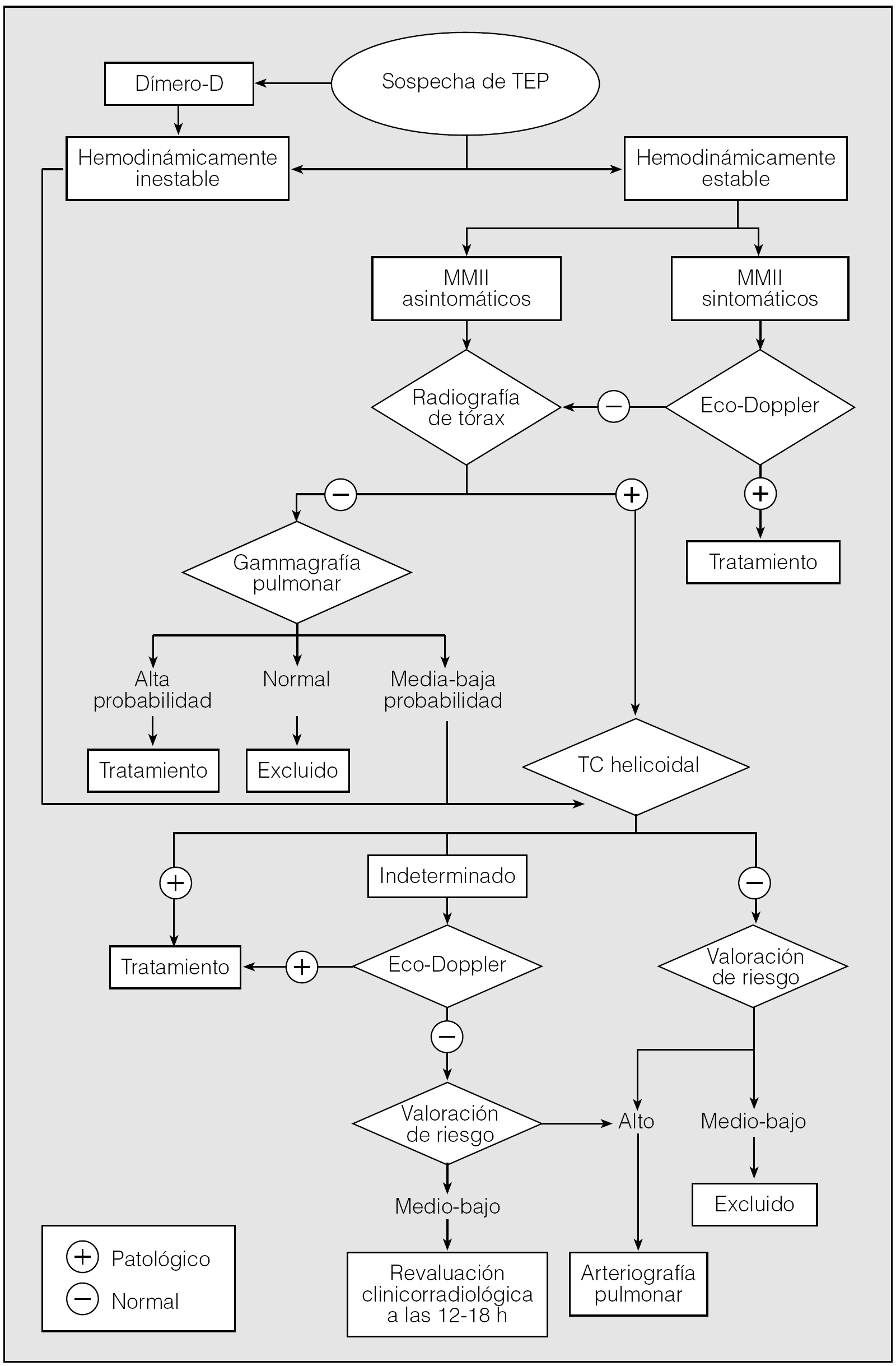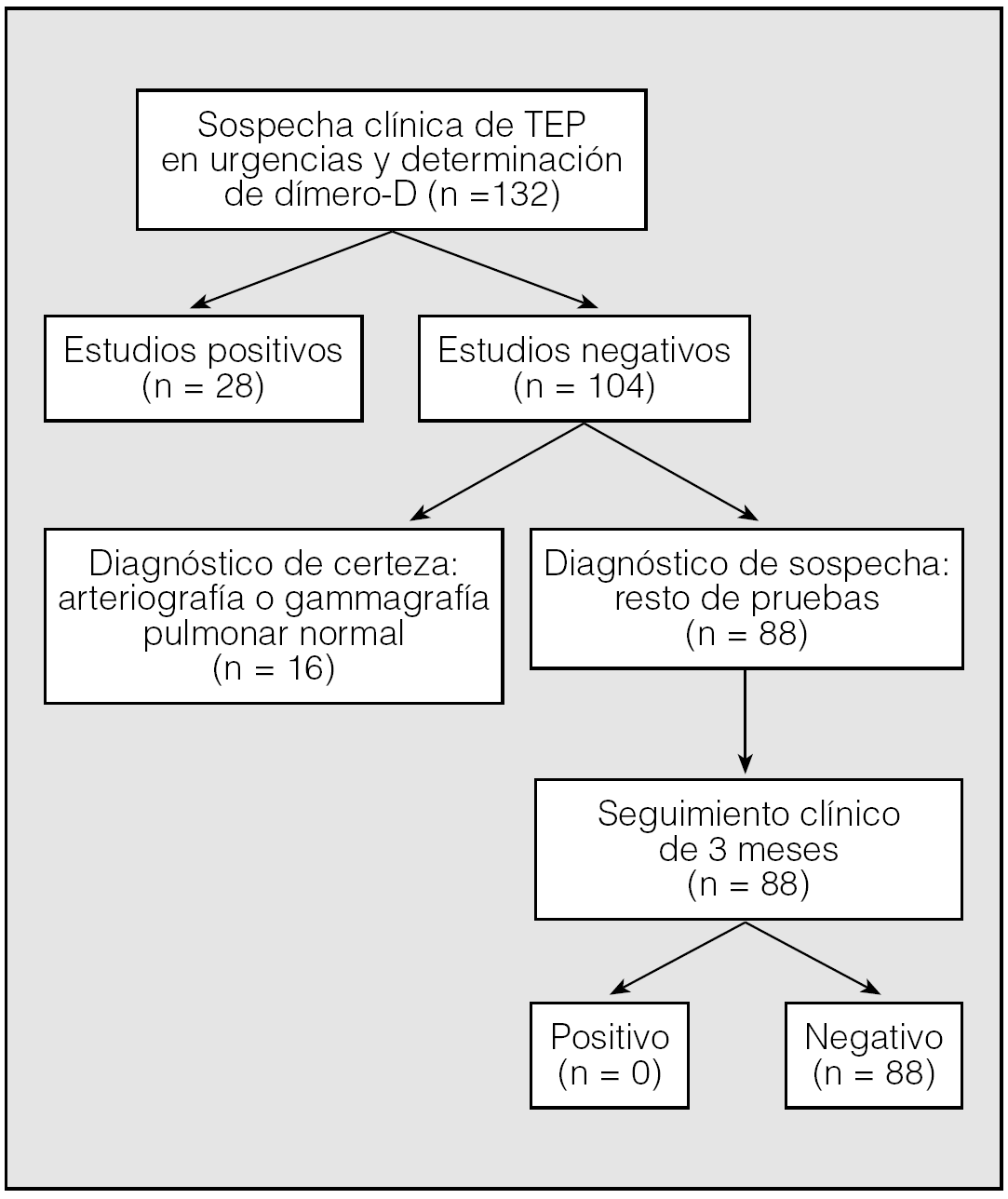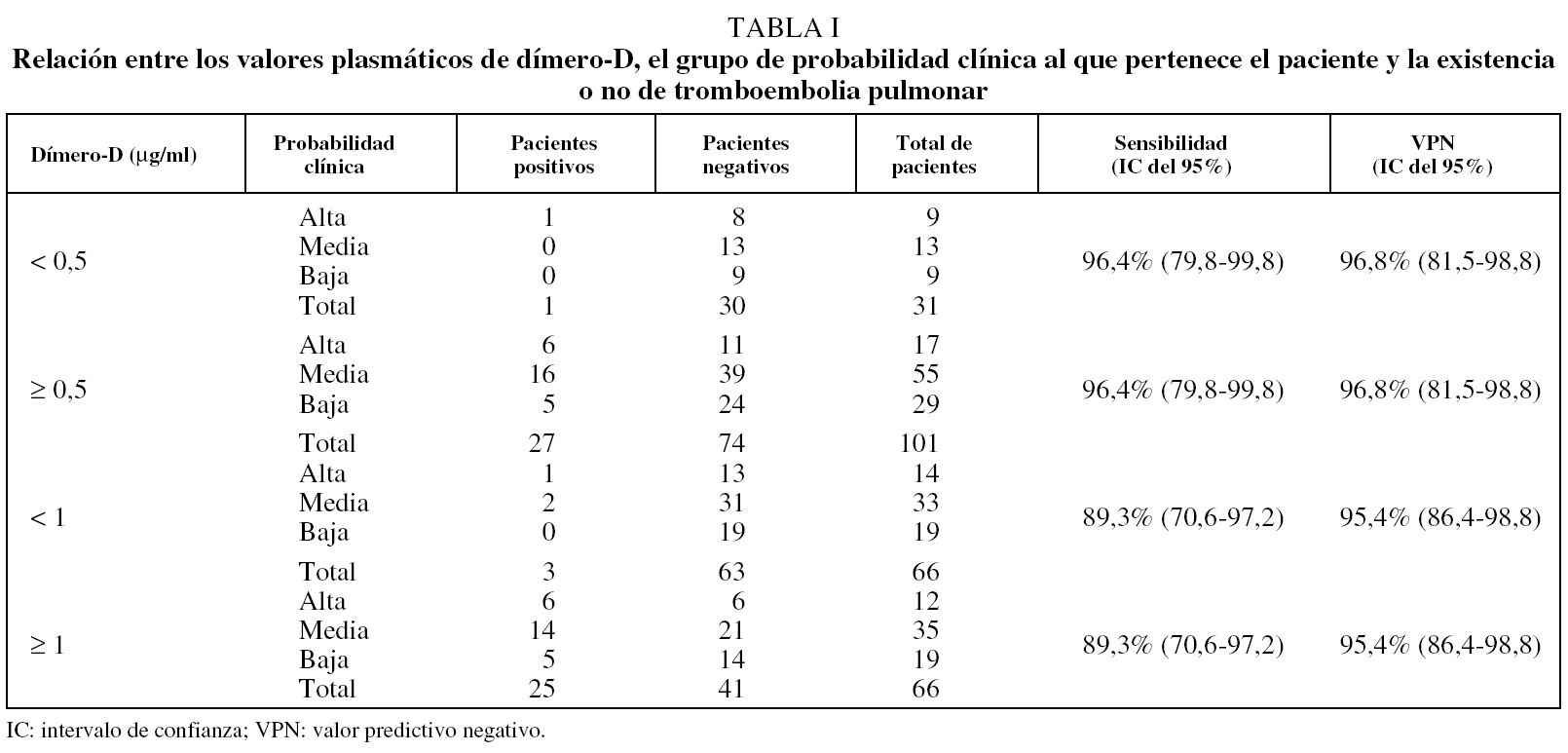Introducción
La embolia pulmonar es una enfermedad frecuente cuyo diagnóstico sigue suponiendo un problema diagnóstico habitual en un servicio de urgencias1. Los datos clínicos y la radiología convencional de tórax son, en la mayor parte de las situaciones, muy inespecíficos para establecer el diagnóstico. La gammagrafía pulmonar ha sido una de las técnicas de imagen más empleadas en los pacientes con sospecha clínica de esta entidad2. Aunque se trata de una técnica muy sensible, es muy poco específica. La tomografía computarizada (TC) helicoidal se ha convertido en los últimos 10 años en la alternativa a los problemas de especificidad de la gammagrafia de V/Q3. La sensibilidad y la especificidad de esta prueba oscilan entre un 53 y un 100% y entre un 81 y un 100%, respectivamente, cuando se compara con la gammagrafía o la arteriografía pulmonar4-6. La TC helicoidal se ha incluido dentro de distintos protocolos de diagnóstico en la sospecha clínica de tromboembolia que combinan distintas pruebas: estratificación de riesgo clínico, valores plasmáticos de dímero-D, ecografía de miembros inferiores y arteriografía pulmonar7-9.
Se ha descrito que el dímero-D posee un alto valor predictivo negativo para el diagnóstico de exclusión de la enfermedad tromboembólica3,7. Su positividad es muy inespecífica y puede encontrarse en la enfermedad tromboembólica venosa y otros procesos patológicos: insuficiencia cardíaca, cirugía, infecciones, conectivopatías y cáncer10,11. Sus valores de detección dependen de muchas variables (especialmente comorbilidad, sedentarismo, paciente ambulatorio hospitalizado, tamaño del trombo, tratamiento anticoagulante y día de estudio tras el accidente) y del método utilizado para su medición7. La aglutinación por látex clásica ha quedado en desuso por su inferior sensibilidad respecto al resto11. Sin embargo, las turbidimétricas y las determinadas por enzimoinmunoanálisis (ELISA) son las más sensibles; el SimpliRED es aún controvertido11. Nuestro estudio pretende establecer la sensibilidad y el valor predictivo negativo del dímero-D mediante la técnica de ELISA rápido (VIDAS) para el diagnóstico de la tromboembolia pulmonar en un servicio de urgencias.
Pacientes y métodos
Se ha realizado un estudio prospectivo de pacientes atendidos consecutivamente entre septiembre de 2002 y julio de 2003 en el Servicio de Urgencias del Hospital de La Princesa de Madrid por sospecha clínica de embolia pulmonar.
Diseño del estudio
Se incluyó a los pacientes que presentaban síntomas indicativos de embolia pulmonar. Los criterios de inclusión fueron los siguientes: sospecha clínica de tromboembolia atendida en el Servicio de Urgencias, edad superior a 18 años y tener realizada una determinación de dímero-D en el momento del ingreso. Los criterios de exclusión fueron: embarazo, edad inferior a 18 años, estar con tratamiento anticoagulante, imposibilidad de realizar un seguimiento clínico posterior durante 3 meses y denegar o retirar el consentimiento informado para las pruebas. El médico responsable clasificó a cada paciente según la probabilidad clínica preprueba (baja, media y alta)8 y solicitó las pruebas diagnósticas para tromboembolia pulmonar basándose en el algoritmo diagnóstico establecido en el Hospital de La Princesa por el Grupo de Estudio de Enfermedad Tromboembólica Venosa (fig. 1). El protocolo incluye distintas pruebas de diagnóstico, entre ellas la radiografía de tórax, la gammagrafía de perfusión, la ecografía venosa de miembros inferiores, la TC helicoidal y la arteriografía pulmonar.
Fig. 1. Diagrama diagnóstico inicial para la tromboembolia pulmonar (TEP) elaborado por el Grupo de Trabajo de la Enfermedad Tromboembólica del Hospital de La Princesa. Los valores de dímero-D se analizaron para su posterior validación. MMII: miembros inferiores; TC: tomografía computarizada.
A los pacientes a quienes se diagnosticó de embolia pulmonar por alguna de estas pruebas se les instauró tratamiento anticoagulante. A aquellos en los que el resultado fue negativo por pruebas no aceptadas como de referencia (ecografía venosa de miembros inferiores combinada con probabilidad clínica baja, gammagrafía de baja probabilidad o TC helicoidal) se les realizó un seguimiento clínico durante 3 meses; la aparición de fenómenos tromboembólicos venosos en este período hizo considerar el caso como positivo. En los pacientes con una gammagrafía de perfusión o una arteriografía pulmonar normales se excluyó el diagnóstico de embolia pulmonar y no se instauró tratamiento ni se realizó seguimiento clínico.
El protocolo de este estudio recibió la aprobación del Comité de Ética de Investigación de nuestro hospital, que no requirió consentimiento informado, salvo el necesario para los procedimientos diagnósticos habituales (TC helicoidal, gammagrafía pulmonar y arteriografía).
Dímero-D
A todos los pacientes se les practicó al inicio una determinación de dímero-D plasmático mediante la técnica VIDAS® D-Dimer (bioMérieux, Lyon, Francia), un método inmunoenzimático de tipo sándwich, en 2 tiempos, con una detección final por fluorescencia (ELFA). La concentración se expresó en microgramos por mililitro de unidades equivalentes de fibrinógeno. El tiempo transcurrido entre la determinación de dímero-D y las pruebas de imagen no superó las 24 h en ningún caso.
Seguimiento clínico
A los pacientes cuyo estudio para embolia pulmonar se consideró negativo mediante la ecografía de miembros inferiores, la gammagrafía pulmonar de baja probabilidad o la TC helicoidal, y a los que no se instauró un tratamiento anticoagulante, se les evaluó clínicamente después de 3 meses. Transcurrido este tiempo, se examinó la historia clínica del paciente. Si ello no era posible, se estableció contacto con el médico de cabecera responsable del paciente o conversación telefónica con el propio paciente o con sus familiares. Se investigó la aparición de posibles signos y síntomas de enfermedad tromboembólica venosa o la instauración de algún tratamiento anticoagulante. Esta forma de realizar el seguimiento clínico, u otras similares, ya la han utilizado otros autores12,13.
Se consideró paciente con enfermedad tromboembólica en los siguientes supuestos: diagnóstico de trombosis venosa profunda mediante ecografía en pacientes con síntomas de embolia pulmonar, o gammagrafía pulmonar positiva, o TC helicoidal positiva, o arteriografía pulmonar positiva o cuando durante los 3 meses de seguimiento clínico precisa definir mejor el seguimiento clínico se registraron fenómenos de enfermedad tromboembólica (trombosis venosa o embolia pulmonar).
Se consideró paciente sin enfermedad tromboembólica en los siguientes supuestos: gammagrafía de perfusión normal, o gammagrafía de perfusión de baja probabilidad en pacientes de probabilidad clínica baja y con seguimiento clínico negativo, o 2 ecografías venosas negativas (al inicio y a los 7 días) en pacientes de probabilidad baja y con seguimiento clínico a los 3 meses negativo, o TC helicoidal negativa con seguimiento clínico a los 3 meses negativo o arteriografía pulmonar negativa. Cuando la TC no fue concluyente, se revaluó al paciente, se solicitaron otras técnicas diagnósticas y se hizo un seguimiento clínico de 3 meses cuando el caso se consideró negativo. En los casos de fallecimiento se valoró como negativo cuando no se detectaron émbolos en la autopsia o cuando la causa de muerte no se relacionó con episodios tromboembólicos venosos.
Análisis estadístico
Para el cálculo de las medias y las desviaciones estándar se ha empleado el programa Excel (Microsoft 2000). Para el cálculo de los intervalos de confianza se ha empleado el programa Confit incluido en el programa Pepi versión 3.0 (JH Abramson & PM Gahlinger, 1993-99). Se han determinado la sensibilidad y la especificidad para los diferentes puntos de corte de los valores de dímero-D por medio de una curva de eficacia diagnóstica. Los datos de valor predictivo negativo se han obtenido utilizando el programa EPIDAT, versión 2.1 para Windows (abril de 1998, Xunta de Galicia).
Resultados
Durante los 10 meses de nuestro estudio hubo 132 pacientes con sospecha de tromboembolia pulmonar, de los cuales 77 eran mujeres (58,3%) y 55 varones (41,7%). La edad media (± desviación estándar) fue de 66,7 ± 17,7 años. En 28 pacientes (21,2%) se confirmó la embolia pulmonar y en 104 (78,8%) el diagnóstico fue negativo. De los 28 pacientes positivos, en 23 la TC fue diagnóstica, en 3 lo fue la gammagrafía de alta probabilidad, en un paciente la ecografía venosa de miembros inferiores demostró una trombosis y en un caso la arteriografía pulmonar fue positiva. De los 104 casos negativos, en 16 el diagnóstico fue de certeza mediante una gammagrafía pulmonar normal o una arteriografía pulmonar negativa.
En los restantes 88 pacientes hubo 3 con baja probabilidad clínica que tenían una gammagrafía pulmonar de riesgo bajo. En un paciente con baja probabilidad la ecografía venosa y una repetición a la semana fueron negativas. En 84 pacientes se realizó una TC que se interpretó como negativa en 79 de ellos. En 5 pacientes de baja y media probabilidad clínica la TC no se juzgó concluyente para embolia debido a mala tinción vascular o a movimientos respiratorios. En 2 de estos pacientes se pudo establecer un diagnóstico alternativo que justificaba el cuadro clínico: un caso de pleuropericarditis y una tumoración hiliar. En los restantes 3 pacientes se completó el estudio mediante ecografía de miembros inferiores que fue negativa. El diagnóstico negativo en estos 88 se completó con un seguimiento clínico a los 3 meses. No hubo pérdidas ni tampoco episodios de enfermedad tromboembólica venosa. Estos datos se resumen en la figura 2.
Fig. 2. Esquema de actuación en los 132 pacientes estudiados en urgencias por sospecha clínica de tromboembolia pulmonar (TEP).
Durante el seguimiento clínico fallecieron 5 pacientes. A 4 de ellos se les había realizado una TC helicoidal, que fue negativa para embolia en 3 y no resultó concluyente en 1. Las causas de muerte fueron fallo multiorgánico en un paciente al que se practicó una autopsia negativa para tromboembolia o trombosis venosa; una paciente con un accidente vascular cerebral presentó un coma hipercápnico y una neumonía; en otro paciente con fibrilación auricular e insuficiencia cardíaca el diagnóstico fue de parada cardiorrespiratoria; el cuarto paciente con estudio no concluyente presentaba un carcinoma pulmonar avanzado con metástasis hepáticas. La quinta paciente fallecida, de 68 años, era asmática y tenía una probabilidad clínica baja para embolia, que se descartó mediante una gammagrafía de baja probabilidad; falleció al día siguiente por una crisis de broncospasmo.
Resultados de dímero-D
Los valores de dímero-D fueron < 0,5 μg/ml en 31 de los pacientes, de los cuales 30 no tuvieron embolia pulmonar y 1 sí la tuvo. De los 101 pacientes con valor de dímero-D > 0,5 μg/ml, en 74 no se produjo tromboembolia y en 27 sí. Si se considera el punto de corte de 1 μg/ml, hubo 66 pacientes con valores inferiores, de los cuales 3 presentaron embolia pulmonar. Otros 66 pacientes mostraron un dímero-D superior o igual a 1 μg/ml, y de ellos 25 tuvieron un diagnóstico positivo para tromboembolia y 41 negativo. Estos resultados, con la sensibilidad y el valor predictivo negativo para estos 2 puntos de corte, se recogen en la tabla I.
Discusión
La embolia pulmonar constituye un importante y frecuente problema de difícil diagnóstico en un servicio de urgencias. Los síntomas son con frecuencia poco específicos, atípicos o bien están enmascarados por otras enfermedades asociadas1,14. La gammagrafía pulmonar es muy sensible pero poco específica. Cuando es normal excluye una tromboembolia pulmonar. Sin embargo, los hallazgos de la gammagrafía considerados de media o baja probabilidad pueden no identificar a un elevado número de pacientes con embolia pulmonar; además, hasta en un 60% de los casos los estudios no son diagnósticos y se requerirán otras pruebas posteriores2,3. Kutinsky et al15 demostraron que sólo una de 98 gammagrafías en pacientes con sospecha de embolia pulmonar resultó normal. De 6 pacientes con gammagrafía de alta probabilidad, en 5 la arteriografía pulmonar fue normal. En los restantes 91 pacientes los resultados no fueron diagnósticos. Diversos autores han evaluado múltiples estrategias diagnósticas para la sospecha clínica de embolia pulmonar, entre ellas la determinación de la probabilidad clínica preprueba, la gammagrafía pulmonar, la ecografía venosa de los miembros inferiores, la TC helicoidal, la arteriografía pulmonar y, recientemente, los valores plasmáticos de dímero-D8,14.
En nuestro hospital se creó un Grupo de Trabajo para la Evaluación de la Enfermedad Tromboembólica venosa en 1999 y se establecieron diagramas diagnósticos tanto para la trombosis venosa como para la tromboembolia pulmonar; el de esta última se detalla en la figura 1. Inicialmente no se consideraron los valores de dímero-D para establecer o descartar el diagnóstico y se determinaron con el fin de establecer unos valores de referencia para nuestro centro. Una vez validados, se han incorporado dentro de los protocolos de diagnóstico como prueba inicial para excluir la enfermedad tromboembólica. Nuestro algoritmo diagnóstico difiere del propuesto por Perrier et al7 en que estos autores incluyen la ecografía venosa de miembros inferiores de forma sistemática, aun en pacientes sin síntomas de trombosis venosa, mientras que nosotros sólo la empleamos en pacientes sintomáticos; además, estos autores no utilizan la gammagrafía pulmonar.
El dímero-D es un fragmento de la degradación de fibrina que puede medirse en la sangre periférica y casi siempre se encuentra aumentado en la enfermedad tromboembólica. Los métodos de detección son variados y con distintos resultados. Las técnicas de aglutinación de látex, incluso de segunda generación, han resultado poco sensibles para descartar de forma fiable una tromboembolia pulmonar10. La técnica ELISA clásica tiene una elevada sensibilidad, pero es compleja, lenta de realizar y poco práctica en un servicio de urgencias7,16-19. Los tests semicuantitativos con aglutinación de látex son rápidos, sencillos y más baratos, pero presentan una sensibilidad limitada (83%) y un valor predictivo negativo del 90% para la embolia pulmonar10, por lo que no se recomiendan como prueba para excluir de forma fiable esta entidad3,10,19. Algunos autores han referido que la técnica de ELISA rápido (VIDAS) es un método cuantitativo rápido, automático, que emplea reactivos preparados unidosis para su uso inmediato7,18,20-22. En trabajos recientes se ha publicado que los valores de dímero-D determinados por la técnica de ELISA rápido tienen un elevado valor predictivo negativo para la trombosis venosa profunda16,17 y que, aplicada como prueba inicial de cribado, puede ser útil para excluir de forma fiable esta entidad. De la misma manera, la determinación de dímero-D mediante las técnicas de ELISA rápido para el estudio de los pacientes con sospecha clínica de tromboembolia pulmonar deberían ser también útiles, aunque los estudios son menos claros a este respecto, por el riesgo de infradiagnosticar el proceso8.
En nuestro hospital se emplea la técnica ELISA rápido (VIDAS), un método inmunoenzimático de tipo sándwich, que tiene la ventaja de ser fácil de usar, rápido, con una menor variación entre los laboratorios y con una buena sensibilidad para la enfermedad tromboembólica7,8,17,18,21. Nuestro grupo de trabajo ha publicado que el dímero-D medido mediante la técnica VIDAS ha demostrado una sensibilidad y un valor predictivo negativo del 98 y el 98,6%, respectivamente, para la trombosis venosa profunda, y los valores negativos pueden servir para excluir con fiabilidad este diagnóstico; sin embargo, los resultados no son tan claros para la embolia pulmonar, por el riesgo que acarrearía un error diagnóstico. Con esta misma técnica, Kruip et al21 no detectaron complicaciones tromboembólicas en el seguimiento clínico de pacientes con sospecha clínica de tromboembolia que presentaban una probabilidad clínica baja y unos valores de dímero-D < 0,5 μg/ml.
Otros trabajos con la técnica rápida ELISA (VIDAS)18,21 han demostrado para la tromboembolia pulmonar una sensibilidad y un valor predictivo negativo del 98-100% y del 99-100%, respectivamente, para un punto de corte de 0,5 μg/ml. En nuestro estudio, tanto la sensibilidad como el valor predictivo negativo han sido del 96% para un punto de corte de 0,5 μg/ml, y para un punto de corte de 1 μg/ml los valores han sido del 89 y del 98%, respectivamente.
Se ha comprobado también cómo los pacientes con embolia pulmonar presentan unas concentraciones medias de dímero-D más elevadas que los que presentan otras enfermedades pulmonares, en especial la neumonía3,18, de tal forma que valores de 9,5 μg/ml tienen una especificidad de un 90% para la embolia. Los valores de dímero-D descienden paulatinamente después de la primera semana de tratamiento anticoagulante, por lo que podría también ser de utilidad para valorar la evolución y recurrencias en esta enfermedad23.
En conclusión, pensamos que los valores de dímero-D, determinados mediante la técnica de ELISA rápido (VIDAS), inferiores a 0,5 μg/ml permiten descartar con seguridad la tromboembolia pulmonar en un servicio de urgencias, aunque cada centro debe validar y establecer sus propios valores diagnósticos para esta prueba.















